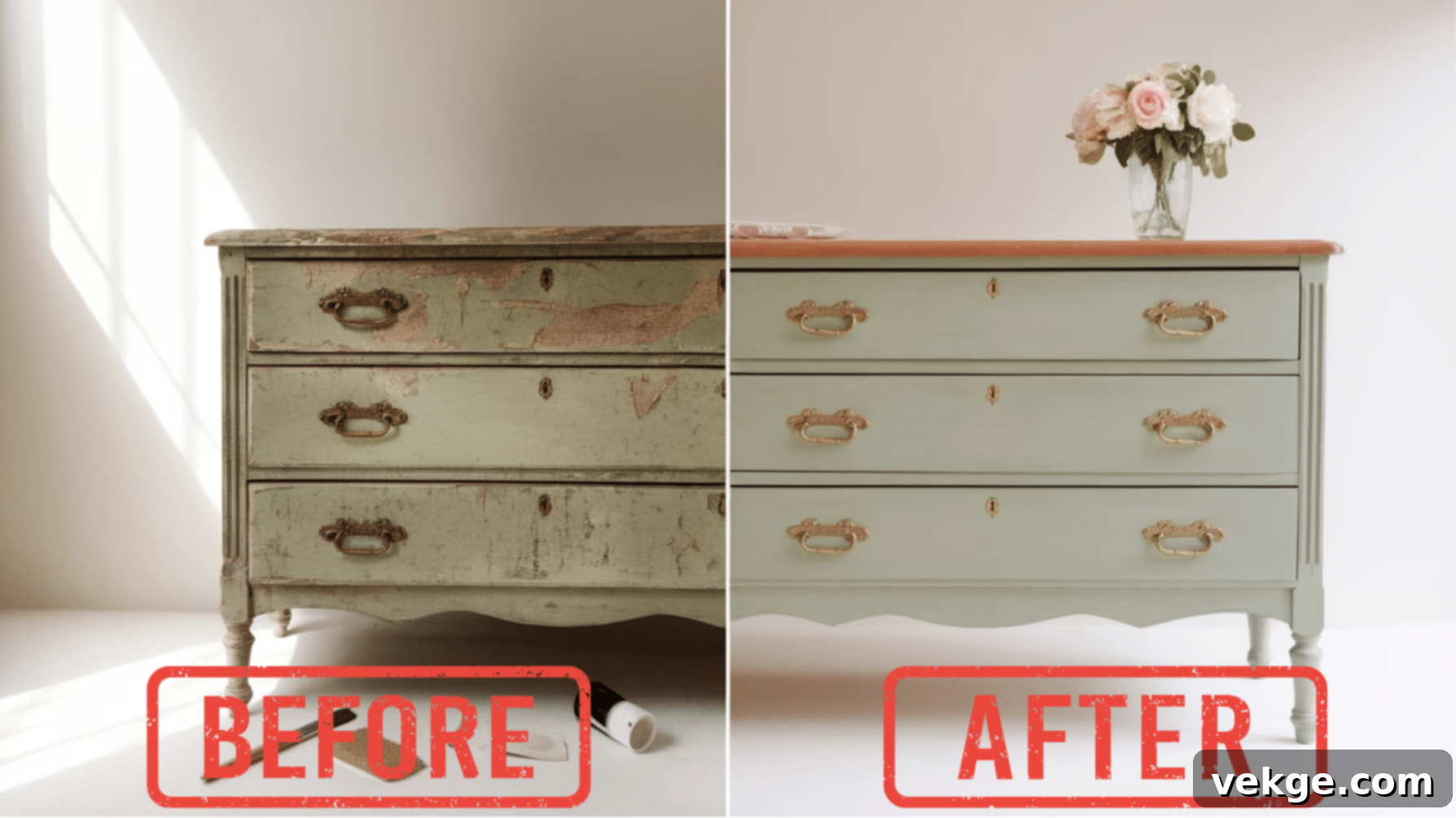Mastering Furniture Upcycling: Your Comprehensive Guide to Revitalizing Old Pieces and Creating Sustainable Home Decor
In an era focused on sustainability and personal expression, the art of furniture upcycling has emerged as a powerful trend. More than just a hobby, it’s a creative journey that transforms forgotten pieces into functional, beautiful items, adding unique character to your home while actively helping our planet. This practice breathes new life into old, often high-quality furniture, preventing it from ending up in crowded landfills and reducing the demand for new, mass-produced goods.
Furniture upcycling is a dynamic and rewarding endeavor. It allows you to infuse your personal style into your living space, creating bespoke pieces that tell a story. Unlike generic store-bought items, upcycled furniture possesses a distinctive charm and history, making your home truly one-of-a-kind. It’s also an incredibly cost-effective way to furnish your home with quality pieces that would otherwise be out of reach.
This comprehensive guide is designed to walk you through every aspect of furniture upcycling. From discovering the perfect base pieces to mastering essential restoration techniques and even exploring the potential of selling your unique creations, you’ll gain practical skills and invaluable knowledge. Whether your goal is to refresh a cherished family heirloom, personalize your home decor on a budget, or embark on a fulfilling small business venture, this guide has you covered.
We’ll delve into the fundamental tools, proven techniques, and insider tricks that ensure successful projects. Prepare to unlock the potential within old wood, faded finishes, and forgotten forms, giving them new purpose, enhanced value, and a stylish second life.
What is Furniture Upcycling?
Defining the Concept
At its core, furniture upcycling involves taking old, discarded, or unused furniture and transforming it into something new and improved, often with a higher aesthetic or functional value than its original form. This process is distinct from recycling, where materials are broken down and reprocessed into new products (e.g., plastic bottles into new plastic). Upcycling, in contrast, preserves the original structure of the item, modifying it through cleaning, repairing, painting, reupholstering, or even repurposing its function entirely.
The practice of upcycling furniture isn’t new; it has roots in necessity and resourcefulness. During the mid-20th century, particularly after periods of economic hardship or wartime, families often mended and updated their existing furniture to save money rather than purchasing new items. This cultural habit of making things last laid the groundwork for modern upcycling.
Evolution Through Time
The 1990s witnessed a resurgence of interest in furniture upcycling, largely driven by growing environmental awareness. As people became more conscious of consumer waste and resource depletion, the appeal of rescuing and revitalizing older, well-made pieces grew significantly. Many recognized that vintage furniture often boasts superior craftsmanship and durable materials, designed to last for generations, unlike much of today’s mass-produced, disposable furniture.
Today, furniture upcycling marries creative expression with a deep commitment to environmental care. It allows individuals to craft personalized pieces that reflect their unique taste while actively diverting usable items from landfills. This eco-conscious approach to interior design has become a cornerstone of sustainable living, encouraging mindful consumption and fostering a sense of pride in handcrafted possessions.
Benefits of Furniture Upcycling
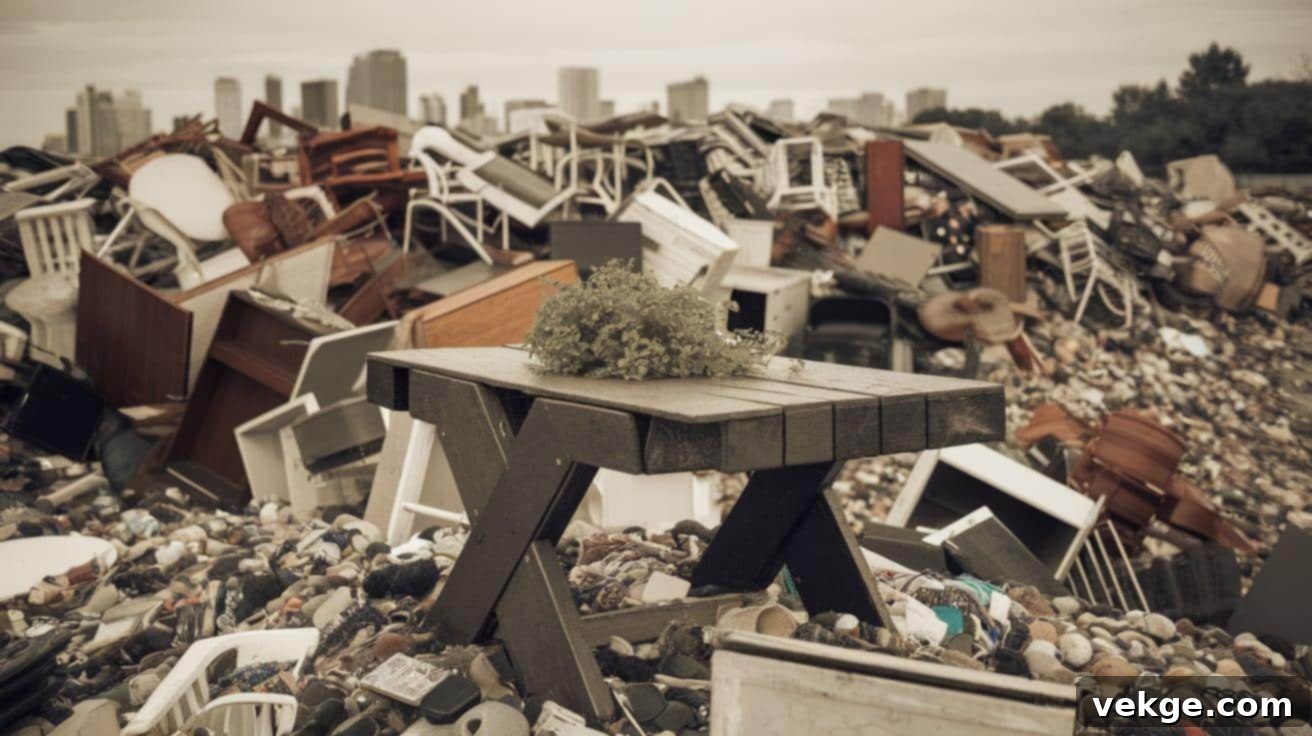
Environmental Impact
One of the most significant advantages of furniture upcycling is its positive environmental contribution. Every single piece of furniture kept out of a landfill is a win for our planet. Landfills are overflowing, and discarded furniture, particularly items made with composite materials, can take centuries to decompose, releasing harmful chemicals into the soil and atmosphere. By upcycling, you reduce waste and minimize your carbon footprint.
Old furniture, especially vintage and antique pieces, often boasts solid wood construction and other high-quality materials built to last for many more years. Upcycling these robust items prevents the need for new raw materials like freshly cut timber or newly mined metals, which saves natural resources and reduces the energy consumption associated with manufacturing new products. Furthermore, modern furniture frequently travels thousands of miles from factories to distribution centers and then to homes. By upcycling locally sourced pieces, you significantly reduce transportation emissions and packaging waste, contributing to a more sustainable, circular economy.
Personal Growth and Creativity
Beyond its ecological benefits, furniture upcycling offers profound personal rewards. The satisfaction derived from creating something unique with your own hands far surpasses the experience of simply buying new items. Each upcycling project presents an opportunity to learn new skills, whether it’s sanding and painting, upholstery, woodworking, or even basic repair techniques. This hands-on experience builds confidence in working with different materials and fosters a deeper appreciation for craftsmanship.
Upcycling is also a powerful outlet for personal expression. It allows you to add truly personal touches to make furniture fit your specific aesthetic and space perfectly. You gain complete control over every aspect of the transformation, from choosing the ideal color palette and decorative techniques to selecting the final finish and hardware. The result is a piece of furniture that is not only functional but also a reflection of your individual style and creativity.
Money Matters and Value
Financially, upcycling costs considerably less than purchasing new furniture of comparable quality. With a relatively basic set of tools and supplies, you can update multiple pieces for a fraction of the price of a single new item. This makes high-quality, stylish decor accessible on almost any budget.
Moreover, quality vintage and antique furniture often features superior construction and more durable materials than many contemporary, mass-produced pieces. While modern furniture can quickly degrade, a well-chosen vintage item, once upcycled, offers exceptional longevity and enduring value. With a bit of care and creative updates, these revitalized items can provide better aesthetic appeal and functional performance for years to come, representing a smart long-term investment in your home’s decor.
Essential Tools and Materials Needed for Furniture Upcycling
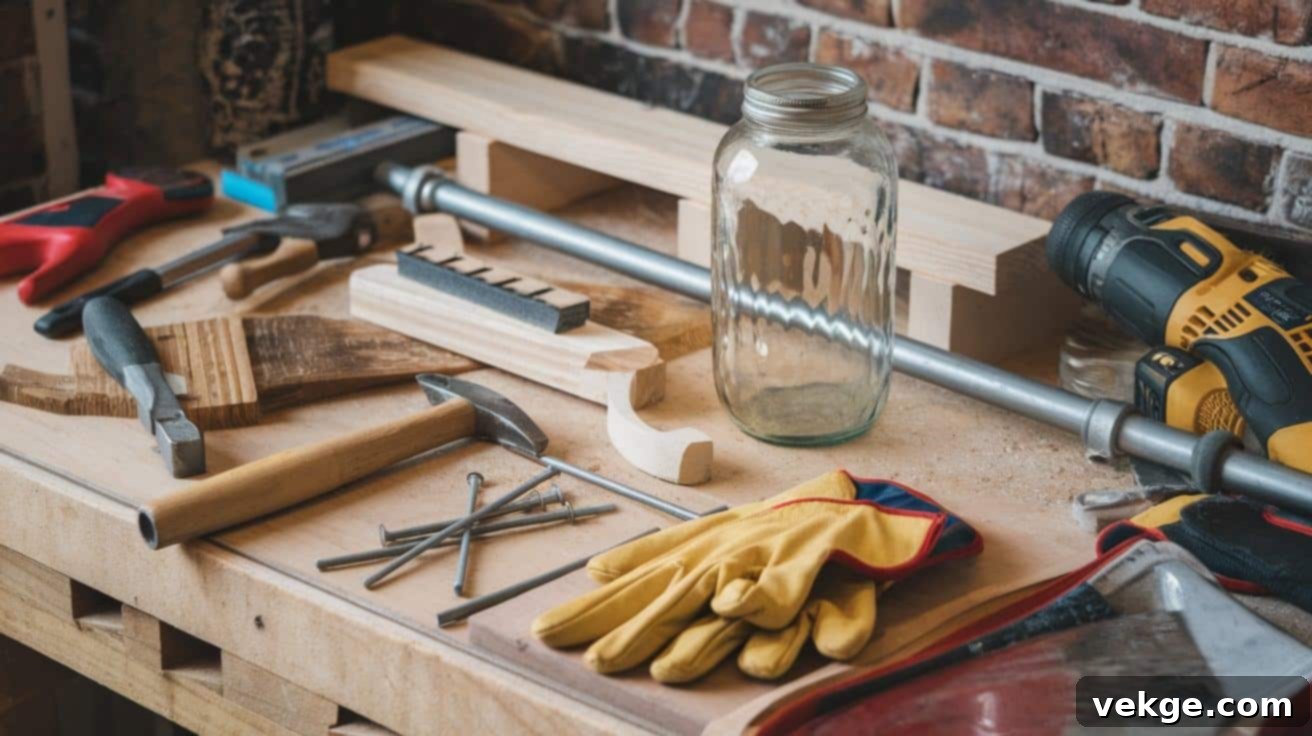
Basic Tools for Beginners
Starting your furniture upcycling journey doesn’t require an extensive workshop. A few key tools form the foundation of most projects. You’ll definitely need a variety of sandpaper in different grits (from coarse 80-grit for stripping to fine 220-grit for smoothing), a selection of high-quality paintbrushes for different applications, and a versatile screwdriver set (Phillips and flathead) for disassembling and reassembling hardware. These fundamental tools will allow you to tackle a wide range of basic repairs and aesthetic upgrades.
Hand tools like pliers, a hammer, and a reliable measuring tape are indispensable for minor repairs and precise adjustments. A putty knife, combined with wood filler or spackle, is perfect for handling small surface imperfections like dings, dents, and nail holes. For cleaning and prep, a good scrub brush, sponges, and buckets are also essential.
Advanced Equipment for Enhanced Projects
As your skills grow and projects become more ambitious, you might consider investing in advanced equipment. Paint sprayers, for example, are excellent for achieving exceptionally smooth, professional-grade finishes on larger pieces like dressers or cabinets, significantly reducing brush strokes and saving time. An electric sander, such as an orbital sander, is a true time and energy saver when preparing big surfaces, making the often-tedious sanding process much more efficient.
Power tools like drills and jigsaws open up a world of more complex project options, enabling you to modify furniture structures, create custom cuts, or add unique features. While these tools require practice and a strong emphasis on safety, they dramatically expand the creative possibilities of what you can achieve with your furniture transformations.
Selecting the Right Furniture for Upcycling

Assessing Potential and Structural Integrity
The success of any upcycling project begins with selecting the right foundation piece. Always look for sturdy furniture with a sound basic structure. Wobbly legs, cracked joints, or heavily split wood can signal deep-seated problems that might be too extensive or costly to repair, especially for beginners. A good rule of thumb is to gently test the stability of the piece by wiggling it. If it feels solid, it’s often a good candidate.
Before committing to a piece, thoroughly check all joints and any moving parts. Drawers should slide smoothly in and out without excessive sticking or wobbling. Doors should hang straight, open and close easily, and their hinges should be intact. Minor hardware issues or cosmetic flaws are usually easy to fix, but fundamental structural damage can quickly turn an exciting project into a frustrating endeavor.
Understanding Material Knowledge
The material of your furniture piece greatly influences the upcycling techniques you’ll use. Solid wood pieces, such as oak, maple, or cherry, generally yield the best results for painting, staining, and distressing projects. They are robust, can withstand multiple rounds of sanding and repainting, and often reveal beautiful grain patterns when stripped. Solid wood furniture offers durability and a timeless appeal that can be enhanced with new finishes.
However, not all furniture is solid wood. Many pieces are made from veneer (a thin layer of real wood over particleboard or plywood) or entirely from particleboard/MDF. Veneer can be upcycled, but sanding must be done very gently to avoid going through the thin layer. Particleboard is less forgiving and generally not suitable for heavy sanding or stripping, often requiring a good primer and paint. Metal furniture, on the other hand, requires a different approach. Surface rust is often manageable with wire brushing and rust-inhibiting primers, but deep, structural rust can compromise the integrity of the piece, making it unsafe or beyond repair.
Prioritize Safety in Your Upcycling Projects
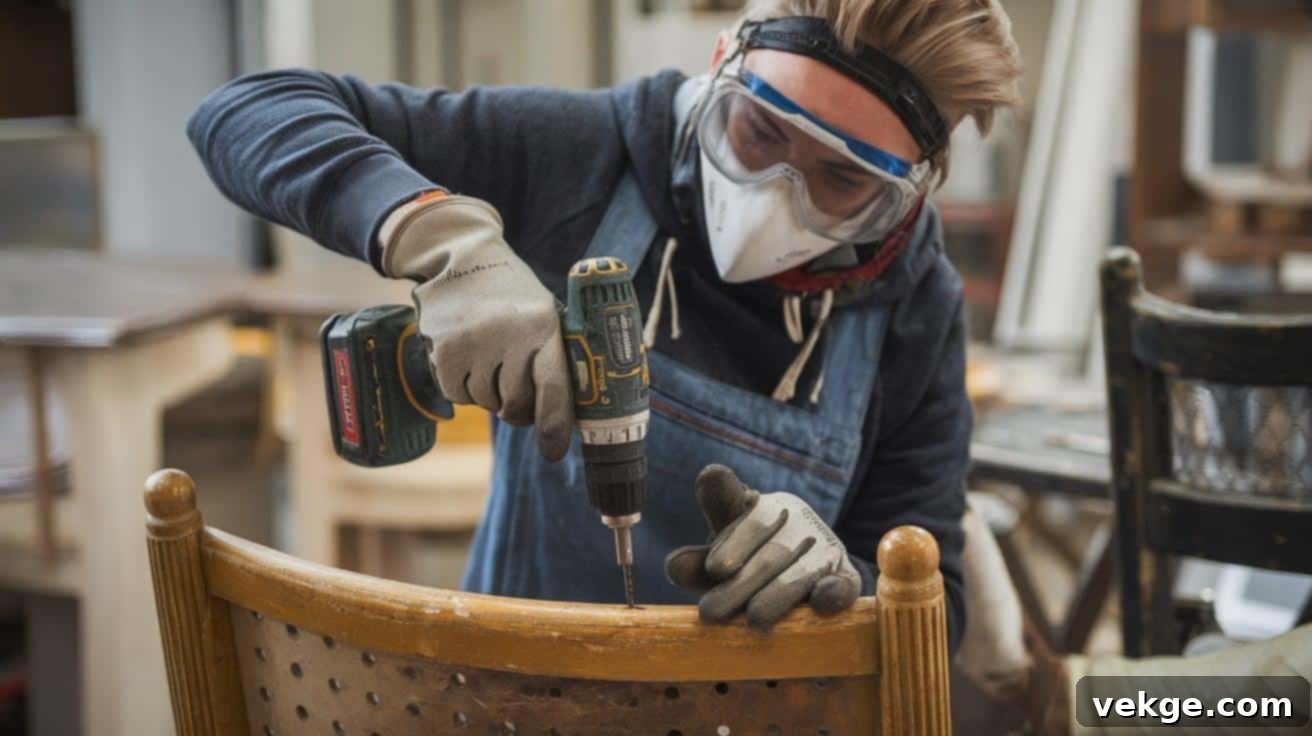
Working with Old Finishes and Hazardous Materials
When upcycling older furniture, it’s crucial to be aware of potential hazards. Old paint, especially on pieces manufactured before 1978, might contain lead, which is highly toxic if inhaled or ingested. Always test old paint for lead using readily available testing kits before sanding or stripping. If lead paint is present, consider encapsulating it with new paint or hiring a professional for removal. Similarly, older varnishes and stains can emit strong fumes. When using paint strippers, chemical cleaners, or even new paints and finishes, always work in a well-ventilated area. Open windows and doors, use fans to create cross-ventilation, and consider working outdoors if possible to ensure proper air circulation and minimize exposure to fumes.
Essential Protection Equipment (PPE)
Personal protective equipment (PPE) is non-negotiable for safe upcycling. Always wear safety glasses or goggles to protect your eyes from flying debris, dust, and chemical splashes, especially when using power tools or working with solvents. Dust masks or, preferably, a respirator (for fine dust and chemical fumes) are essential to protect your lungs during sanding, painting, and when using any aerosol products. Inhaling fine wood dust or paint particles can lead to respiratory issues over time.
Work gloves are vital for guarding your hands against splinters, sharp edges, and irritating chemicals. Different types of gloves are available for different tasks – general work gloves for handling wood, and chemical-resistant gloves for paint stripping. If you’re working with heavy pieces or power tools, steel-toed shoes can protect your feet from falling objects or accidental tool drops, completing your safety ensemble.
Finding Furniture to Upcycle: Your Treasure Hunt Begins
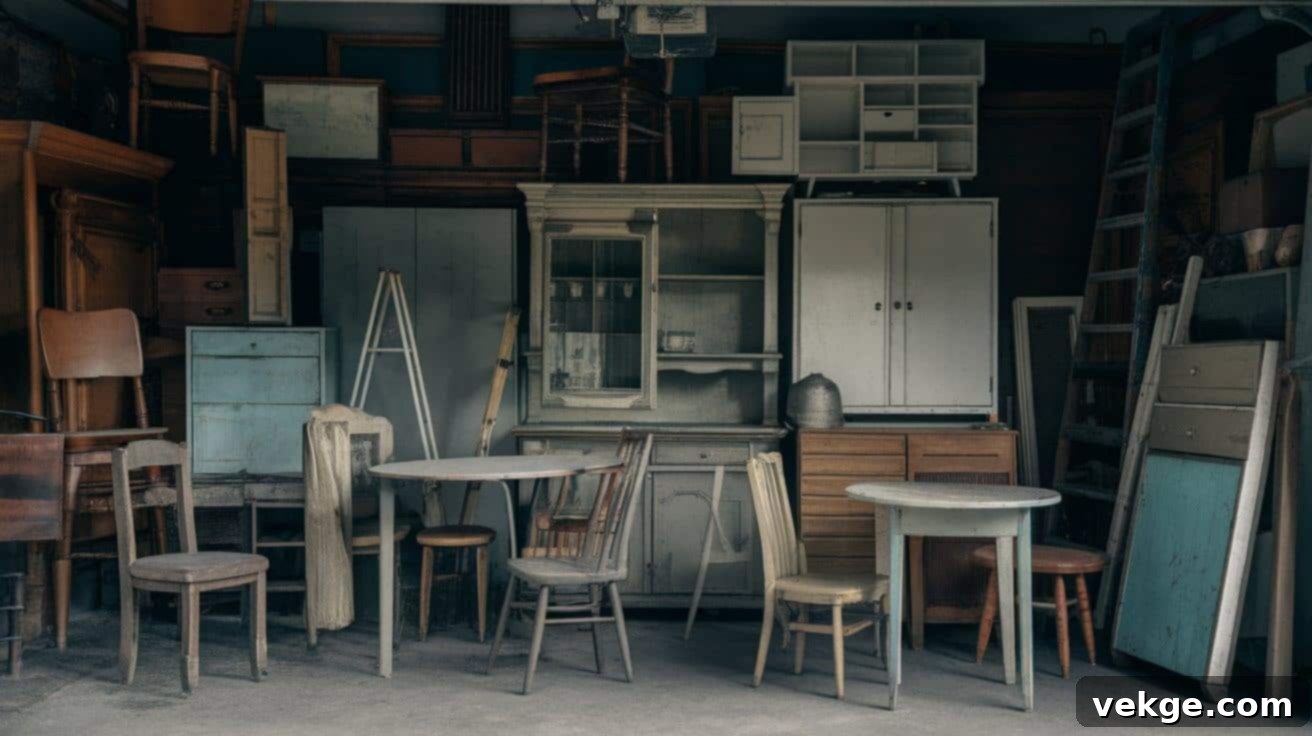
1. Hidden Treasures in Your Own Home
Often, the best place to start your treasure hunt is right under your nose. Begin by looking around your own home for forgotten or overlooked pieces. That dusty cabinet banished to your garage could be transformed into a stylish kitchen island with a new countertop and a fresh coat of paint. A worn-out dresser in the guest room might become a chic bathroom vanity with a basin cut-out and a moisture-resistant finish.
Don’t forget to explore your attic, basement, or other storage areas for stored furniture. Old family pieces frequently boast better quality materials and construction than many new items. These heirlooms often carry sentimental value, making their transformation even more meaningful. With a fresh perspective, you can reimagine existing items into functional and beautiful pieces that perfectly suit your current needs.
2. Making Smart Choices and Envisioning New Uses
When considering a piece for upcycling, approach it with fresh eyes and an open mind. Imagine new uses and aesthetic possibilities beyond its original function. For example, a sturdy but outdated small dresser could easily be repurposed into an elegant bathroom vanity or a charming bedside table. A vintage trunk could become a coffee table with added legs or extra storage at the foot of a bed.
Consider the size, shape, and inherent qualities of items you already own or find. Sometimes, combining elements from two different pieces can create one truly stunning and unique item. A solid tabletop paired with interesting new legs, or mismatched drawers painted uniformly, can lead to surprisingly harmonious results. The key is to see beyond the current state and envision the transformed potential.
3. Thrift Stores and Charity Shops: Goldmines for Upcyclers
Finding Value and Quality
Thrift stores and charity shops are classic hunting grounds for upcyclers. To find the best selection, visit early in the day, especially on weekdays. Many stores receive new donations daily, so frequent visits increase your chances of snagging a gem. Always scrutinize the construction quality: gently wiggle joints, test the stability of legs, and slide drawers in and out. “Good bones” – a sturdy, well-built frame – are far more important than current appearance, as cosmetic flaws are usually easy to fix.
Getting Good Deals and Insider Tips
Cultivate relationships with store managers or staff; they might offer insights into new arrivals or upcoming sales. Some stores have specific discount days for items that have been on the floor for a longer period. Always ask about sale days, senior discounts, or special events that can help you save even more money on your project pieces. Patience and regular visits are key to finding incredible deals.
4. Online Marketplaces: Digital Treasure Hunts
Smart Shopping and Alert Strategies
Online marketplaces like Craigslist, Facebook Marketplace, Gumtree, or local classifieds are abundant sources for affordable furniture. Search these sites frequently, particularly in the early morning and late evening, as many sellers post items during these peak times. To stay ahead of the curve, set up alerts for specific keywords you’re looking for (e.g., “wooden dresser,” “vintage cabinet,” “side table”). This ensures you’re notified instantly when a potential project piece becomes available, allowing you to act quickly before others snatch it up.
Safe Meetups and Transportation
When arranging to pick up items, prioritize safety. Always meet sellers in well-lit, public places during daylight hours if possible. Many local police stations offer designated “safe exchange zones” for online transactions. Never go alone to pick up large furniture; bring a friend or family member, and ensure you have proper transportation, such as a truck or a vehicle with ample cargo space. Having an extra pair of hands makes moving furniture safer and much easier.
5. Alternative Sources for Unique Finds
Estate Sales and Auctions
Estate sales are fantastic sources for high-quality, often vintage, furniture. Visit early on the first day for the widest selection, although prices will typically be higher. Alternatively, if you’re hunting for a bargain, return on the last day of the sale when prices are often drastically reduced by 50% or even more. Local auctions can also offer incredible deals on solid furniture, but be sure to inspect items thoroughly before bidding.
Community Resources and Curbside Gems
Keep an eye out for neighborhood cleanup days or bulk trash collection schedules. People frequently discard perfectly good furniture they no longer want, providing excellent opportunities for “curbside finds.” Always check local listings for yard sales, garage sales, sales, and flea markets, especially during spring and fall, as these seasons often yield the most furniture options. Don’t be shy to ask friends, family, or neighbors if they have any old furniture they’re looking to get rid of; you might be surprised at what hidden gems they have!
Furniture Upcycling Techniques and Methods: Bringing Your Vision to Life
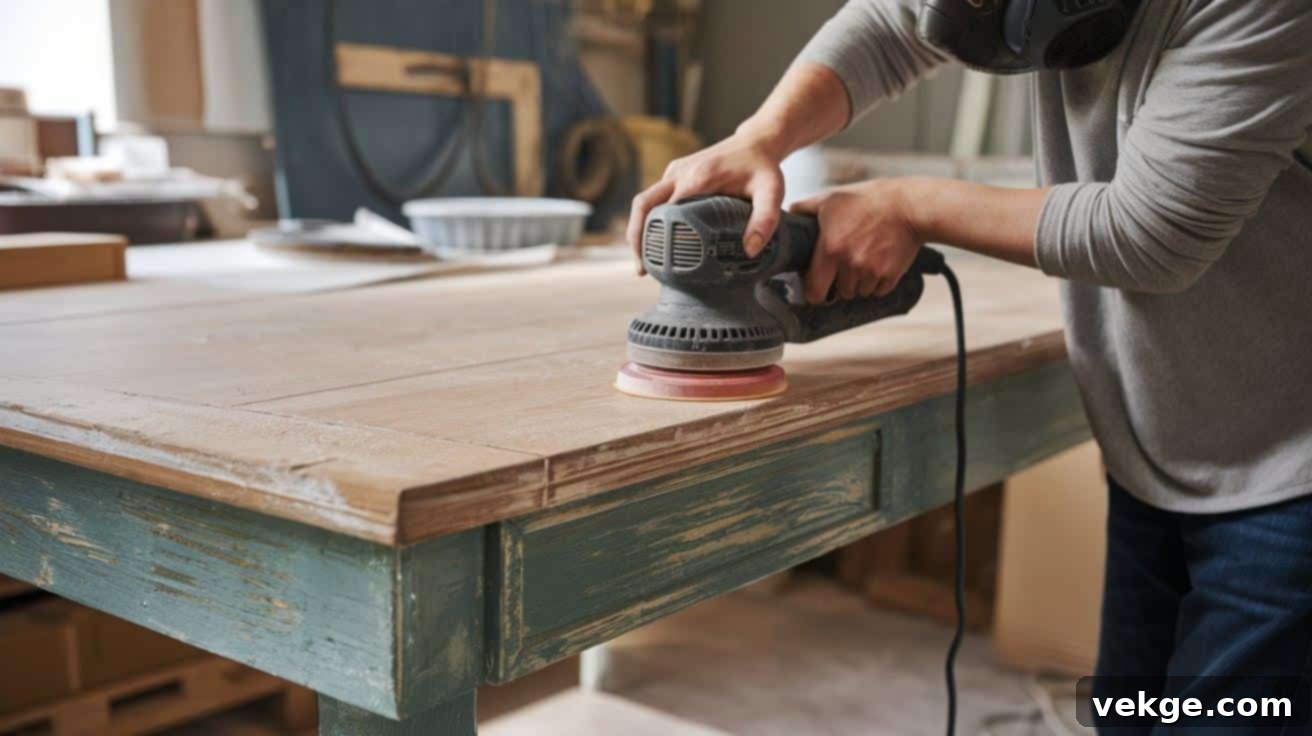
1. Thorough Preparation: The Foundation of Success
Proper preparation is the most critical step in any furniture upcycling project, ensuring a durable and beautiful final result. Begin by thoroughly cleaning the piece with a good degreaser or mild soap and water to remove all surface dirt, grime, oil, and old polishes. This step is crucial, as it reveals the true condition of your furniture and allows subsequent layers to adhere properly. Pay special attention to hidden spots, crevices, and corners where dirt can accumulate.
Next, carefully sand old finishes to create a smooth, even base for your new paint or stain. Start with a coarser grit sandpaper (e.g., 80 or 100 grit) to remove stubborn finishes or deep scratches, then progressively move to finer grits (150, 220) for a silky-smooth surface. Always sand with the grain of the wood. After sanding, wipe away all dust with a tack cloth or damp rag. Fill any holes, dents, or deep scratches with a high-quality wood filler or epoxy putty. Apply in thin layers, allowing each layer to dry completely before lightly sanding it flush with the surrounding surface. For veneered pieces, sand very lightly to avoid damaging the thin veneer layer.
2. Painting and Finishing: Adding Color and Protection
Choosing the right paint and finish is vital for both aesthetics and durability. Consider the intended use of your furniture: a kitchen table, for instance, requires a much tougher, more resilient finish (like an enamel paint with a durable topcoat) than a purely decorative accent piece. Always test paint colors on a hidden spot or a scrap piece of wood first, as different wood types and underlying finishes can subtly affect how colors appear.
When applying paint, aim for thin, even coats rather than one thick layer. Thin coats prevent drips, dry more consistently, and allow the paint to adhere better, creating a smoother, more professional finish. Allow each coat to dry fully according to the manufacturer’s instructions before applying the next. Lightly sand between coats with a very fine grit sandpaper (e.g., 220-320 grit) to remove any imperfections and promote better adhesion. Finish with a suitable topcoat (polyurethane, wax, or clear lacquer) to protect your newly painted surface from wear and tear.
3. Decorative Techniques: Adding Personal Flair
Decorative techniques allow you to infuse your personality into your upcycled furniture. Try simple geometric patterns on drawer fronts, tabletops, or side panels using painter’s tape to create crisp, clean lines and shapes. Experiment with different brush strokes or tools to add unique textures, such as dry brushing for a weathered look or stippling for a subtle tactile effect. Small changes in technique can create significant visual impacts.
For upholstered pieces, carefully remove old fabric, often using it as a pattern for cutting new material. Take plenty of photos before you start disassembling to aid with reassembly. Choose sturdy fabrics that are appropriate for the furniture’s use; dining chair seats, for example, require more durable, stain-resistant material than a purely decorative accent pillow. Other techniques include decoupage with decorative papers, stenciling intricate designs, or replacing old hardware with stylish new knobs and pulls to instantly update a piece’s look.
4. Transformative Upcycling: Redefining Function
Transformative upcycling goes beyond a cosmetic update; it involves repurposing a piece for an entirely new function. An old dresser, for instance, can be converted into a stylish storage bench by removing some drawers and adding a cushioned top. Kitchen cabinets can be reconfigured into custom entertainment centers by adding holes for cords, adjusting shelf heights, and installing new doors.
Don’t be afraid to mix and match parts from different pieces to create something truly original. Vintage table legs can support a custom-cut tabletop, or old drawers can be mounted on a wall for unique shelving. Always think about how people will use the finished piece. Good function is just as important as good looks. Consider ergonomics, durability, and practical accessibility to ensure your transformed furniture is both beautiful and highly usable.
Upcycling Business Insights: Turning Your Passion into Profit
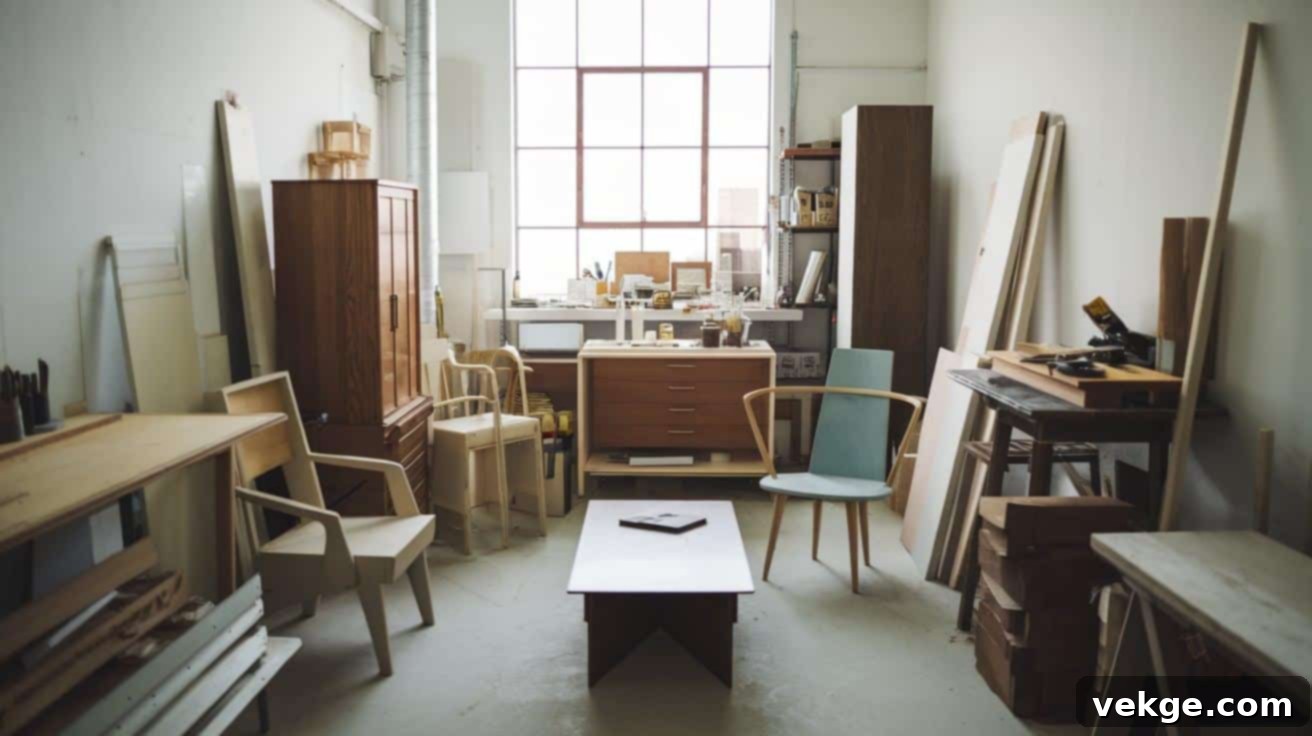
1. Is Furniture Upcycling a Profitable Venture?
Absolutely! The market for unique, updated, and sustainable furniture is experiencing consistent growth each year. Consumers are increasingly seeking pieces that tell a story, offer individuality, and align with eco-conscious values, moving away from mass-produced items. Many local and online markets have a noticeable lack of custom, handcrafted furniture options, creating a significant opportunity for small businesses to thrive. Buyers today are willing to pay a premium for handmade quality, thoughtful design, and the character that only upcycled pieces possess, making it a viable and fulfilling way to earn an income.
2. Starting Your Upcycling Business
Begin modestly to build your confidence and refine your style. Start by completing a few signature pieces that showcase your talent and vision. This allows you to hone your skills, understand your niche, and develop efficient processes before taking on client orders or large-scale production. It’s beneficial to pick a specific style (e.g., farmhouse chic, mid-century modern, bohemian) or type of furniture (e.g., dining sets, accent tables, children’s furniture) as your initial focus. This helps you develop expertise and a recognizable brand. Always keep meticulous records of all your costs and the time spent on each project. This detailed information is crucial for accurately pricing your work and understanding your profitability.
3. Pricing Your Work Fairly and Competitively
Accurate pricing is essential for profitability. First, meticulously add up all material costs, including the purchase price of the furniture, sandpaper, paint, brushes, wood filler, hardware, and any other supplies. Even small items add up! Next, calculate your labor time at a fair hourly rate, accounting for every minute spent on the project, from sourcing and shopping for materials to preparation, painting, finishing, and even photography and listing. Finally, research local market prices for similar upcycled or custom items. Your prices should reflect the quality of your work, the time invested, and your unique artistic touch, while also remaining competitive within your local or online market. Don’t undersell your craft!
4. Effective Selling Platforms for Upcycled Furniture
Variety is key when it comes to selling. Local craft markets, flea markets, and weekend vendor events allow buyers to see and feel your work in person, often attracting serious furniture shoppers looking for unique finds. For online sales, create clear, bright, high-resolution photos that truly showcase your pieces. Highlight details, unique features, and provide accurate dimensions. Platforms like Etsy, Facebook Marketplace, your own e-commerce website, or specialized local online art/craft marketplaces are excellent choices. Consider partnering with local consignment shops or antique malls for steady exposure; they handle sales in exchange for a percentage, freeing you up to create more pieces.
5. Smart Marketing Strategies to Grow Your Brand
In today’s visual world, marketing is paramount. Share your upcycling process on social media (Instagram, Pinterest, TikTok) with captivating “before & after” photos and short video clips. People love seeing the transformation and the effort that goes into each piece. Encourage happy customers to leave reviews and refer new clients; word-of-mouth is one of the most powerful marketing tools. Build a simple, professional website or an online portfolio to display your best work, include your contact information, and detail your services. Finally, maintain contact with past customers through email newsletters or social media updates. Let them know about new inventory, special offers, or even offer custom commission services to foster loyalty and repeat business.
Common Challenges and Solutions in Furniture Upcycling
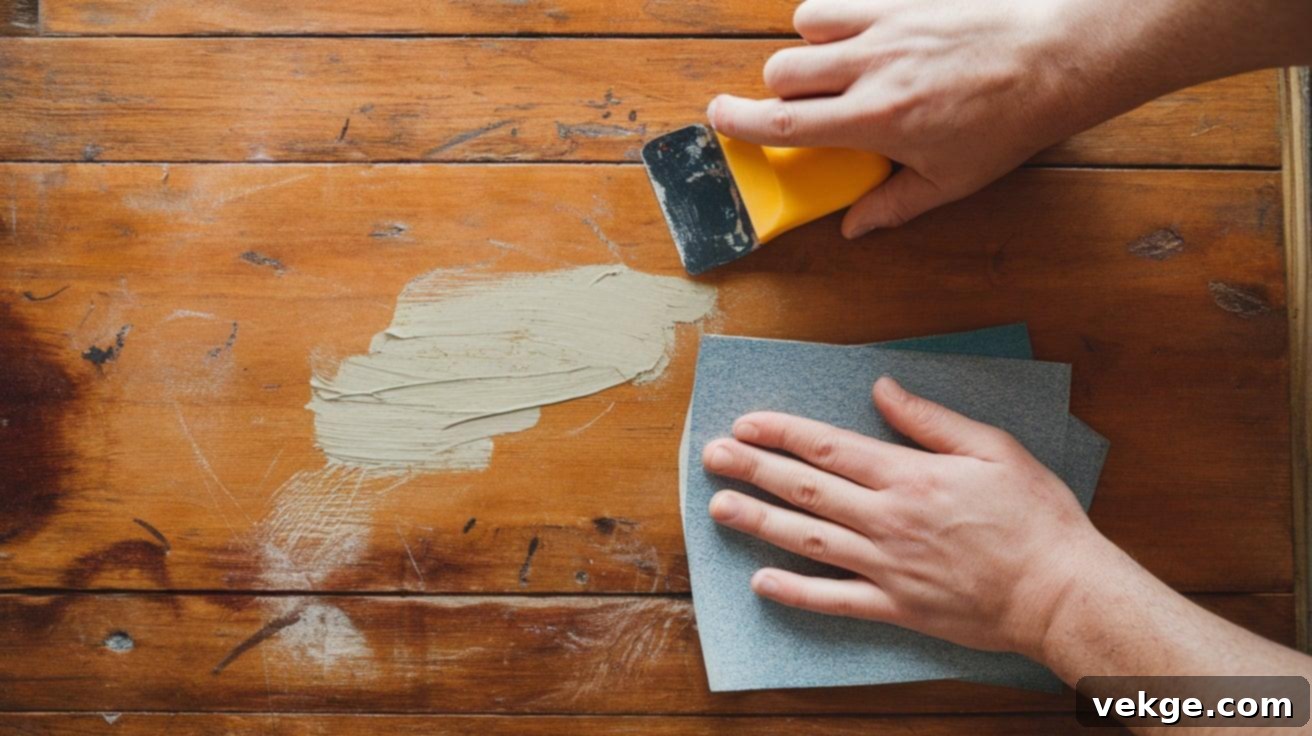
Dealing with Damaged Furniture Effectively
It’s rare to find a piece of old furniture in perfect condition, but most damage is fixable with the right techniques. Loose joints and minor splits in wood can often be repaired with a strong wood glue and proper clamping; simply apply glue, press the parts together, and hold them securely with clamps until fully dry. For broken or stiff drawer slides and rusty hinges, replacing them with new, modern hardware can make furniture function like new again, dramatically improving its usability. Deep scratches, gouges, or holes should be filled in several thin layers with wood filler or epoxy putty, allowing each layer to dry completely before sanding smooth. For significant structural damage or pest infestations (like termites), it might be wiser to pass on the piece unless you have advanced woodworking skills or can hire a professional.
Avoiding and Fixing Common Mistakes
Even experienced upcyclers make mistakes, but many can be avoided or easily fixed. Always test new products—whether it’s a primer, paint color, or topcoat—on a hidden spot or a scrap piece first. This helps prevent undesirable reactions or color outcomes in visible areas. If you get paint drips, address them while they’re wet by gently brushing over the area to smooth out the surface. Once dry, drips are much harder to fix and usually require sanding down and repainting the area. For a consistently smooth finish, lightly sand between each coat of paint. Use a very fine-grit sandpaper (e.g., 320-400) with light pressure to remove any dust nibs or minor imperfections without removing too much paint. Finally, maintaining a clean and organized workspace is paramount. Good habits, such as cleaning brushes immediately, covering paint cans, and tidying up after each step, prevent the most common errors and ensure a more enjoyable workflow.
Time Management and Project Planning
Upcycling projects can often take longer than anticipated, but effective time management can mitigate frustration. Before starting any project, set up your workspace by gathering all necessary tools and materials. Having everything ready saves valuable time during the actual work. Break down large projects into smaller, manageable tasks (e.g., cleaning, sanding, priming, first coat, second coat, topcoat). Focus on completing one section or step thoroughly before moving to the next. Crucially, schedule adequate drying time between each step; resist the urge to rush, as proper drying leads to a more durable finish. Use this waiting time productively to prep your next piece, clean tools, or plan future projects. Creating a checklist for each type of project helps track progress, ensures no steps are missed, and allows for consistent results. Lastly, keep basic supplies like sandpaper, brushes, and wood filler stocked so you don’t waste time making emergency runs to the store in the middle of a project.
Sustainability and Environmental Impact of Furniture Upcycling
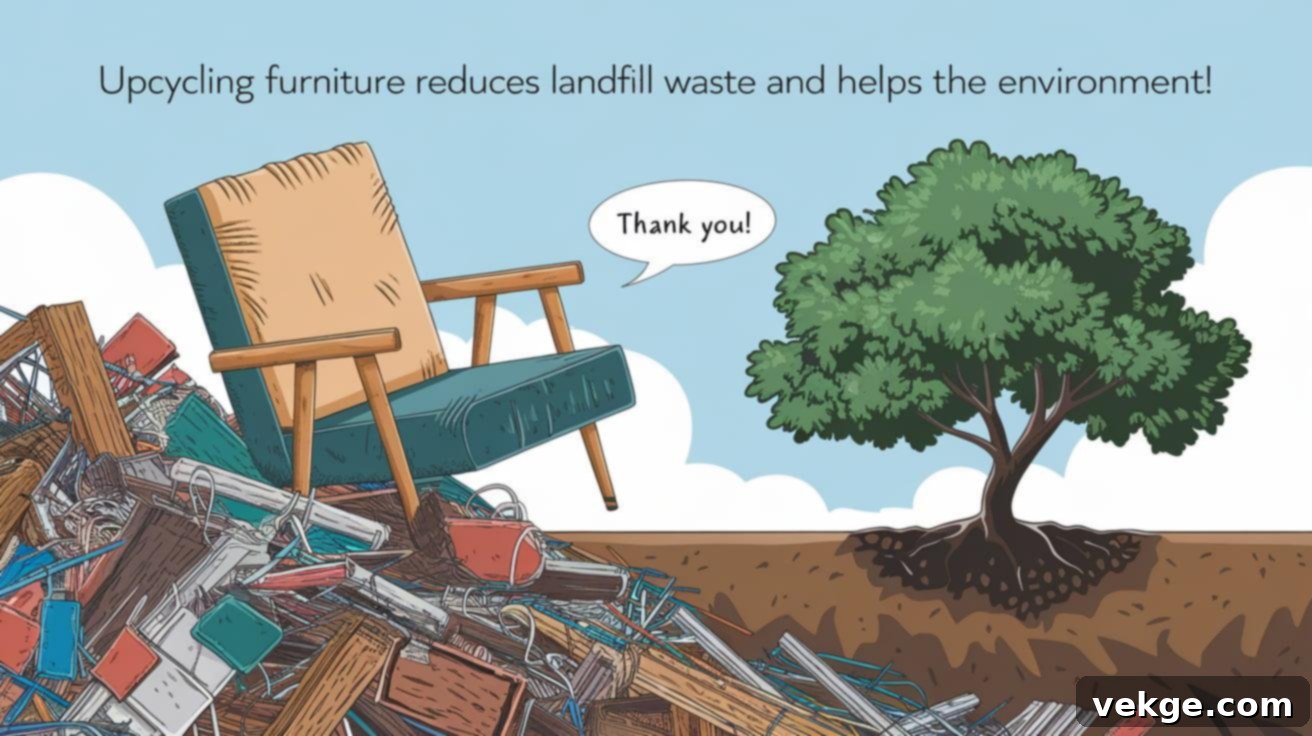
1. The Pivotal Role of Upcycling in Reducing Waste
The sheer volume of discarded furniture is a silent environmental crisis. Each year, millions of furniture pieces, from chairs and tables to wardrobes and beds, are sent to landfills globally. Many of these items are still perfectly functional or easily repairable, but they’re discarded due to changing tastes, minor damage, or the appeal of fast, cheap furniture. This contributes significantly to landfill waste, which consumes valuable land and can release harmful greenhouse gases as materials decompose. By choosing to upcycle, we intercept these items, dramatically reducing the amount of waste generated. Furthermore, old furniture often contains superior, more durable materials—like solid hardwoods, metals, and quality joinery—compared to the engineered wood products (particleboard, MDF) prevalent in much of today’s new furniture. Extending the life of these well-made pieces is a direct form of resource conservation and waste prevention.
2. Promoting Sustainable Practices Beyond Your Workbench
Your individual upcycling efforts have a ripple effect. Share your completed projects and your upcycling journey with friends, family, and on social media. Simple before-and-after photos or quick tutorial videos can inspire others to try their hand at furniture transformation. Offer to help neighbors see the potential in their old pieces, or organize a community workshop to teach basic upcycling skills. Local schools, community centers, and clubs are often keen to host demonstrations or hands-on projects that promote creativity and environmental awareness. By promoting sustainable practices, you become an advocate for a circular economy, where resources are kept in use for as long as possible, extracting maximum value from them, then recovering and regenerating products and materials at the end of each service life.
3. Expanding Upcycling Beyond Furniture
The philosophy of upcycling isn’t limited to furniture; it’s a mindset that encourages creative reuse across all aspects of life. Learn to look at all discarded items with “new eyes” and imagine their potential second life. Old windows can be transformed into rustic picture frames or decorative wall art. Solid core doors can become stunning tabletops with a new base or even headboards for beds. Beyond the home, consider upcycling clothing into new garments or accessories, glass jars into decorative storage or vases, and even plastic containers into organizers. Thinking about future uses while working on any project, or before discarding items, helps to cultivate a habit of creative problem-solving and prevents waste at every step. This holistic approach to upcycling fosters innovation and contributes to a more resourceful and sustainable lifestyle.
Conclusion: Embrace Your Upcycling Journey for a Sustainable Future
Embarking on your furniture upcycling path is an incredibly rewarding experience that opens doors to boundless creativity and a more eco-friendly lifestyle. Each piece of furniture you rescue and revitalize not only adds unique value and character to your home but also makes a tangible positive impact on our planet by reducing waste and conserving resources.
Remember that every expert was once a beginner. Start with simple projects to build your confidence and gradually expand your skills over time. Your proficiency and personal style will naturally evolve with each finished piece, leading to a deeper sense of accomplishment and creative satisfaction.
Always prioritize safety in your workspace and take the time to learn and apply proper techniques for preparation, painting, and finishing. Quality results are a direct outcome of careful planning, meticulous execution, and the patience to allow each step its due process.
Don’t hesitate to connect with the vibrant and supportive community of furniture upcyclers, both online and in your local area. Share your successes, seek advice, and learn from the collective experiences of others. This community can be an invaluable source of inspiration, tips, and encouragement.
Your work, no matter how small, contributes significantly to the bigger picture of waste reduction and sustainable living. Every single piece you transform means one less item destined for a landfill, and one more beautiful, unique item enriching someone’s home. So, gather your tools, find that forgotten gem, and start your upcycling project today. That old piece of furniture isn’t just wood and dust; it might just become your next favorite, most cherished item, filled with new life and a story of its own.
